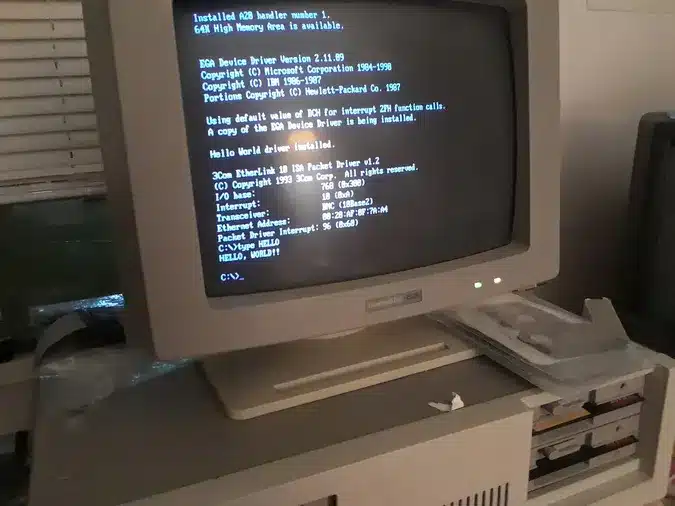The use of MS-DOS in healthcare settings, especially in hospitals to perform tests such as spirometry, may seem anachronistic in an era dominated by modern operating systems such as Windows, macOS or Linux; however, there are technical, economic and practical reasons that explain why many healthcare facilities continue to rely on computer-based systems MS-DOS for specific medical applications such as spirometry.
Spirometry: Why MS-DOS PCs Still Exist to Do It
There are several reasons why spirometry machines still use MS-DOS, and here is an analysis of the reasons.
Software reliability and stability
MS-DOS (Microsoft Disk Operating System) is a monolithic operating system developed in the 1980s and 1990s. Despite its age, it has demonstrated great stability and reliability over the years. In healthcare, these features are crucial, as diagnostic tools must function without interruptions or malfunctions, especially when it comes to collecting essential medical data such as spirometry, a test that measures lung function and can detect serious conditions such as asthma, COPD (chronic obstructive pulmonary disease), or other respiratory diseases.
Medical devices designed in the past decades were built with hardware and software that required an extremely simple operating system free of modern complexities. MS-DOS, being a command line operating system and lacking complex graphical interfaces, requires very limited hardware resources (as well as lower processing power) and tends to be much less vulnerable to errors than modern operating systems, making it ideal for spirometry equipment that requires continuous, uncomplicated functionality.
Spirometry tools etc.Hardware Compatibility
Many of the medical devices used for spirometry were designed and built in the 1980s and 1990s. These devices are based on hardware that works perfectly with MS-DOS and may not be compatible with modern operating systems; Changing the operating system on such specific and dated machines would require a complete redesign of the hardware or the adoption of expensive adapters or emulators to maintain compatibility.

Furthermore, the communication interfaces between the computer and the spirometry device are often based on serial protocols (RS-232) or other technologies that were standard in the MS-DOS era. These protocols are perfectly handled by MS-DOS, while on modern operating systems, such as Windows 10 or 11, compatibility or latency issues may arise, as these systems are designed to handle much more complex operations.
Upgrade and interoperability costs
One of the main reasons hospitals continue to use MS-DOS is the cost of upgrading equipment, and medical equipment is extremely expensive and often designed to last for decades.
Upgrading these machines to run modern operating systems would not only require purchasing new software and hardware, but also a complete training process for medical and technical staff.

Furthermore, hospitals operate on limited budgets, especially in public facilities or in health systems with limited resources; as long as the equipment is functioning properly and meets safety and quality standards, there is no urgent need to replace it.
Planned obsolescence is not a primary factor in healthcare: the emphasis is on long-term reliability.
The upgrade would also pose interoperability issues with other systems already in place in the hospital. MS-DOS is already well integrated into many existing infrastructures, and a move to a more modern system could lead to greater complexity in connecting with other healthcare technologies, such as image archiving systems (PACS), electronic patient records (EMRs), or other diagnostic devices.
Cybersecurity and Vulnerabilities
Ironically, in a world where operating systems often need to be updated, this does not apply to MS-DOS (or its open source counterpart FreeDos) and Using an obsolete operating system like MS-DOS offers some level of security against modern cyber threats.
Being a monolithic system, not connected to the Internet and without the ability to run complex softwareis immune to most malware, ransomware and viruses that target modern operating systems and this “technological isolation” makes MS-DOS a safe choice for many medical devices, which must protect sensitive patient data.

Additionally, many modern systems are vulnerable to continuous update issues. Modern operating systems require regular updates to fix bugs, security vulnerabilities, and other issues; in a hospital environment, where business continuity is crucial, The fact that MS-DOS does not require constant updates is an advantage in terms of security and reliability.
SSimplicity of spirometry software
The software used for spirometry testing is generally very simple in terms of computational requirements. It must handle the data input from the measuring device, perform basic statistical calculations and provide a graphical or numerical representation of the results.
MS-DOS is perfectly adequate for performing these types of tasks, without the need for an advanced graphical interface or superior processing power.
Programming in environments such as MS-DOS is relatively simple. and does not require the complexity of modern languagesmaking software maintenance easy for skilled technicians.
Technological legacy and lack of pressure for change
Many hospitals maintain outdated systems because the transition to new systems is not perceived as a priority, especially if the current infrastructure meets day-to-day needs; among other things The lack of regulatory or legislative pressure to force an upgrade is pushing many healthcare organizations to postpone the transition to more modern technologies.
This phenomenon is often described as “legacy systems lock-in” (legacy lock-in), where the cost and complexity of upgrading equipment and software is perceived as too high compared to the benefits achievable; until serious problems occur, or regulations are introduced that force an upgrade, Many hospitals prefer to continue using established and secure technologies such as MS-DOS.
Conclusion
The use of MS-DOS for spirometry and other medical equipment is the result of a combination of technical, economic, and practical factors.

Although it may seem outdated, MS-DOS provides a stable, secure, and cost-effective environment for performing medical tests that do not require complex technology; compatibility with older hardware, protection against modern cyber threats, and low maintenance costs make MS-DOS still a viable choice in many healthcare settings.especially in the absence of external pressure to upgrade.
Ultimately, this scenario reflects how efficiency and reliability are often prioritized over technological modernity in the medical field, where patient safety and device reliability are of primary importance.
#Spirometry #MSDOS